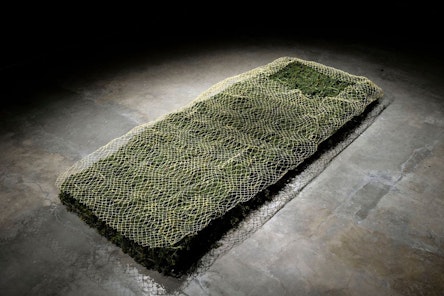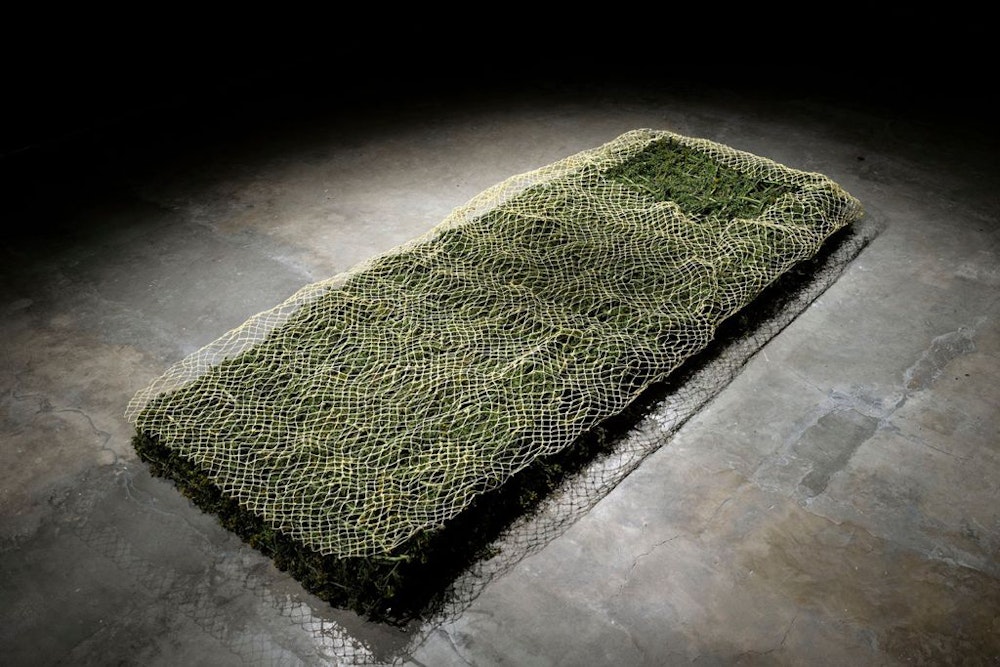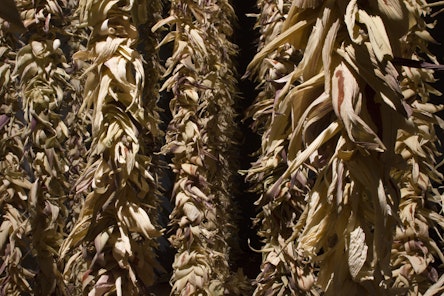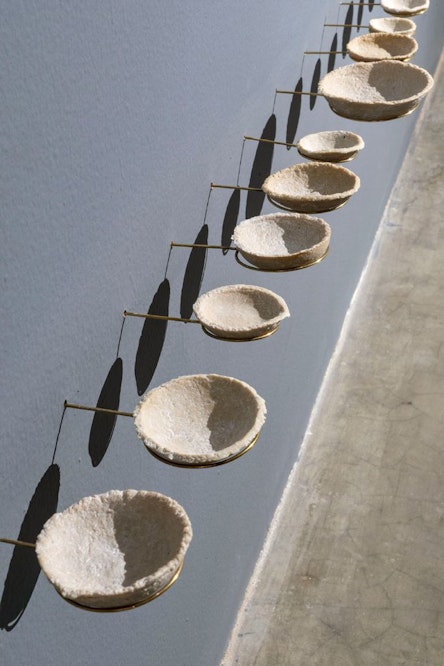
Arrullos, Juliana Góngora's exhibition at Espacio Continuo gallery, persuing the artist's extensive research about ephemeral materials, sometimes digestible, generally unusual: spider and milk threads, grains of rice and sand, corn husks and cumare fibers. Arrullos will be shown on the second floor of the gallery, an installation made with columns of corn leaves and drawings in mineral soil and oil, a video that follows the path of a drop on the surface of a cave and, finally, a set of nests made of cumare, fiber of a palm essential for the indigenous coreguaje and whose manufacture implies a wisdom on which their community depends. On the third floor, we find the work Body of milk, a fabric made by the artist for the grave of her grandfather, the Ofrendatarios - glass containers in the shape of a breast to make, as the name implies, offerings - and the milk bowls , for which the artist carries out a whole process with the material: from subtracting the casein to the use of lime as a binder. As can be seen in these descriptions, the presence of the mother and the earth is crucial, the feminine, and of a sacredness of the materials that strips art of its secular condition, to return it to the ritual and sacred. By: Julia Buenaventura
Espacio Continuo takes as reference the concerns that motivated plastic explorations in Latin American modern art, finding conjunctures with contemporary practices. Aware of its legacy, we intend to explore its continuity and behavior in current artistic practices. Finding exercises that juxtapose cross-cutting questions, we invite the viewer to find conductive threads about artistic research that have common starting points. We want to become a moderating space for these explorations that strengthen encounters, creating dialogues between past and present. Espacio Continuo now addresses the diffusion of local artists of mid and stablished career.


Juliana Góngora, 1988. Observer of the moss between the bricks and of the minuscule powers. She works with primitive and organic materials: earth, salt, spider threads, grains of sand, stones, glass, milk. She collects sculptural conditions: strength, subtlety, pressing, waiting, suspending, moistening. As an artist she incites material consciousness and asserts that as a species we need to start describing more of our daily actions instead of exposing our discourses of power. The earth is my principle of reflection. My floor. I approached it because it presented me with a limit: the most human of all. Dealing with something heavier than my body and trying to control it is a challenge. With it I understood that sculpture is not intellectual research but a relationship with matter that evolves over time. I learned about patience. That the processes of sculpture, like those of life, are not immediate. That art and life cannot be distanced. That we are entangled with matter and our relationship with it is physical and human. I understood that I was not going to play the artist's double game. That what I had chosen for my life, art, was going to be life itself. The easiest thing to do is to go to one extreme. The most complicated thing is to stand in the tension field. Knowing how much force I use to achieve something in the material is an important sculptural conscience and I believe that the political condition of sculpture is to allow oneself to leave a mark by always thinking about the accumulation of force that we use to make it. From its excess or scarcity comes violence, abandonment, unconscious surrender. I believe that as a species we need to start describing more our daily actions instead of exposing our discourses of power. Interview and compilation: Ana Cristina Ayala R.


Juliana Góngora, 1988. Observer of the moss between the bricks and of the minuscule powers. She works with primitive and organic materials: earth, salt, spider threads, grains of sand, stones, glass, milk. She collects sculptural conditions: strength, subtlety, pressing, waiting, suspending, moistening. As an artist she incites material consciousness and asserts that as a species we need to start describing more of our daily actions instead of exposing our discourses of power. The earth is my principle of reflection. My floor. I approached it because it presented me with a limit: the most human of all. Dealing with something heavier than my body and trying to control it is a challenge. With it I understood that sculpture is not intellectual research but a relationship with matter that evolves over time. I learned about patience. That the processes of sculpture, like those of life, are not immediate. That art and life cannot be distanced. That we are entangled with matter and our relationship with it is physical and human. I understood that I was not going to play the artist's double game. That what I had chosen for my life, art, was going to be life itself. The easiest thing to do is to go to one extreme. The most complicated thing is to stand in the tension field. Knowing how much force I use to achieve something in the material is an important sculptural conscience and I believe that the political condition of sculpture is to allow oneself to leave a mark by always thinking about the accumulation of force that we use to make it. From its excess or scarcity comes violence, abandonment, unconscious surrender. I believe that as a species we need to start describing more our daily actions instead of exposing our discourses of power. Interview and compilation: Ana Cristina Ayala R.


Juliana Góngora, 1988. Observer of the moss between the bricks and of the minuscule powers. She works with primitive and organic materials: earth, salt, spider threads, grains of sand, stones, glass, milk. She collects sculptural conditions: strength, subtlety, pressing, waiting, suspending, moistening. As an artist she incites material consciousness and asserts that as a species we need to start describing more of our daily actions instead of exposing our discourses of power. The earth is my principle of reflection. My floor. I approached it because it presented me with a limit: the most human of all. Dealing with something heavier than my body and trying to control it is a challenge. With it I understood that sculpture is not intellectual research but a relationship with matter that evolves over time. I learned about patience. That the processes of sculpture, like those of life, are not immediate. That art and life cannot be distanced. That we are entangled with matter and our relationship with it is physical and human. I understood that I was not going to play the artist's double game. That what I had chosen for my life, art, was going to be life itself. The easiest thing to do is to go to one extreme. The most complicated thing is to stand in the tension field. Knowing how much force I use to achieve something in the material is an important sculptural conscience and I believe that the political condition of sculpture is to allow oneself to leave a mark by always thinking about the accumulation of force that we use to make it. From its excess or scarcity comes violence, abandonment, unconscious surrender. I believe that as a species we need to start describing more our daily actions instead of exposing our discourses of power. Interview and compilation: Ana Cristina Ayala R.